Jobtech
Jobtech/Arbetsförmedlingen
(digital career guidance)
How to help adults in the middle of their working life, to find alternative paths when unpredictable things happens?
Jobtech
How to help adults in the middle of their working life, to find alternative paths when unpredictable things happens?

Context
The assignment to develop a coherent data infrastructure for skills supply and lifelong learning (CLL) is distributed over several different authorities. In 2022, a semantics project has been underway to investigate the conditions for a common nomenclature that can strengthen the conditions for digital services in the labor and skills development market. Work has also been done to get an overall summary of all programs via the Swedish National Agency for Education, the Swedish Agency for Higher Education and UHÄ.
Society talks about the need for transition in the middle of working life. If we start from the individual Agne who is in the middle of life. Agne has a profession that is difficult to get work in, may have occupational injuries that mean that they cannot continue in the profession or just want to try something new. Agne has a lot of skills and education in the profession. Parts of this can be very useful in other professions. Agne is unsure of how her skills can be used in other professions.
Educational descriptions can often be perceived as abstract; What professions can you get? What does it mean to work in the profession? What does the labor market look like, both now and in the future? What courses take advantage of Agnes' skills and build on them?
By linking education to job advertisements and labor market trends, these questions can be easier to answer.
The challenge
It became evident to us that the task was quite extensive, and we had to streamline our focus areas. Prioritization was necessary to ensure the timely delivery of a completed product.
The primary customer demographic for the client comprises women aged 20 to 35.
It is expected that the user has professional experience. There are already many services for those who are new to the labour market
The needs of the labor market and the education sector's offer.
A sub-purpose is to work with external development partners to evaluate whether JobTech's infrastructure and documentation are useful for external development organizations. (Many similar initiatives involve AF building additional services of its own.)
in how JobTech's and other data infrastructure can be used to build services.
My role
The decision to work solo on this project, provided me with the opportunity to evaluate my abilities of carrying out every single aspect of the project and at the same time, working on two parallel projects.
While working on this project I focused heavily on research in order to understand the available tools.
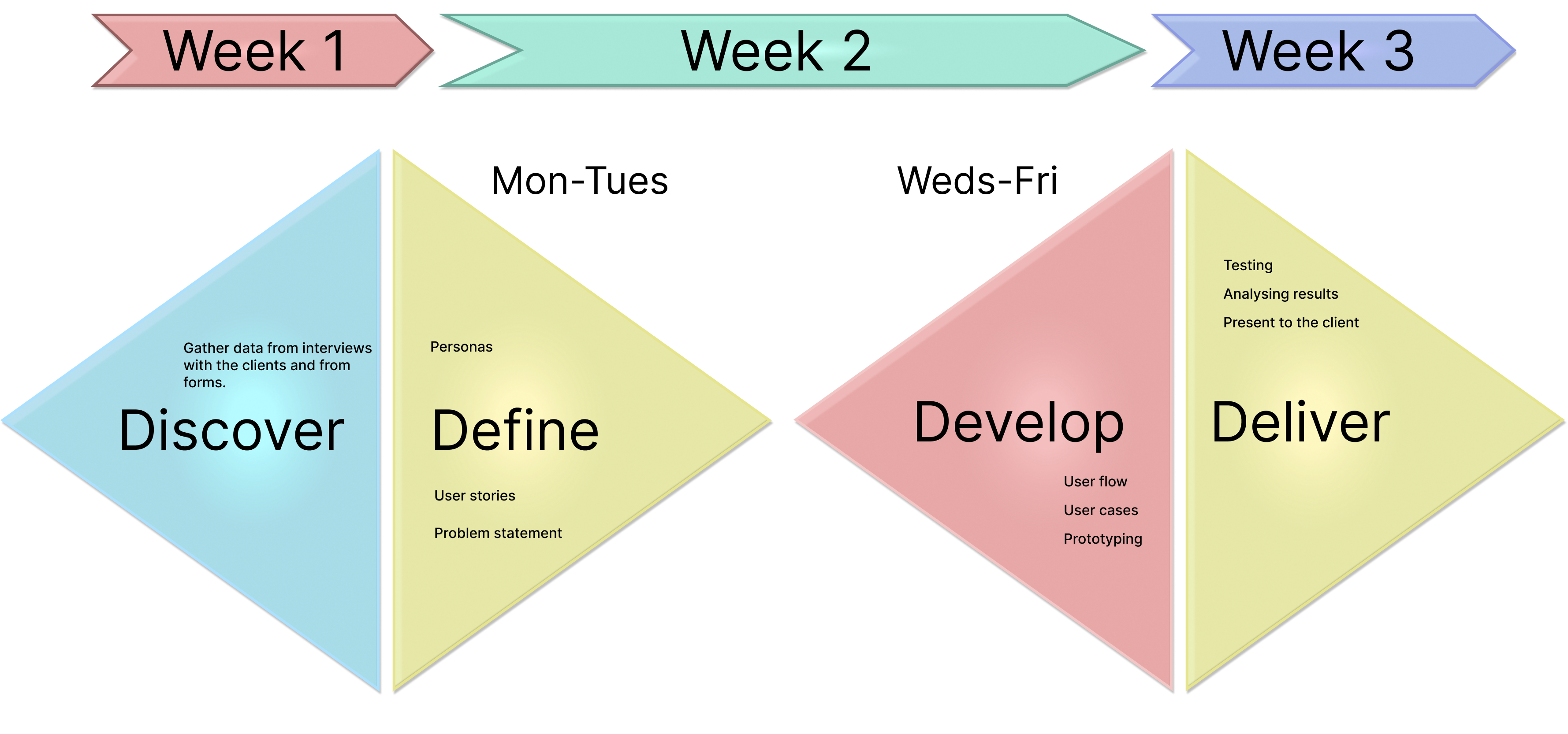
.png)


Assignment
In this particular case, our persona was already created. Below follows an extract from the case introduction.
A platform that is available to job seekers in the middle of their professional lives, where you in a structured, fun (feel free to use your gamification knowledge) and easy way are guided, inspired, and get job proposals based on their CV and suggestions for nearby jobs based on interest, personality and other kinds of life experiences and skills. Within the project, ethical aspects of recommendations will be considered to break the dominance in different professions, such as gender or background.
He needs assistance to be able to choose a new path.
Creates their CV using ready-made tags and suggestions to support them to improve their CV and complete their profile. (Feel free to inspire gamification) He also fills in his personal abilities and interests. Then he gets 12 job suggestions that he can apply for now, + 67 related jobs. Tap Related Jobs.
Agne find some interesting works but think, I've never thought about those. why have I received them as suggestions. Select one of them and press "About results".
Competitors
There are many other websites in Sweden that offers the same range of services. But there is no service that has it all. Different pages offers different kind of features. Some services, even pulls their data and statistics from arbetsförmedlingen’s website when it comes to prognosis, statistics, salaries and other categories. Being a governmental agency, Arbetsförmedlingen, offers some services that other sites do not include.
There are many other websites in Sweden that offers the same range of services. But there is no service that has it all. Different pages offers different kind of features. Some services, even pulls their data and statistics from arbetsförmedlingen’s website when it comes to prognosis, statistics, salaries and other categories. Being a governmental agency, Arbetsförmedlingen, offers some services that other sites do not include.
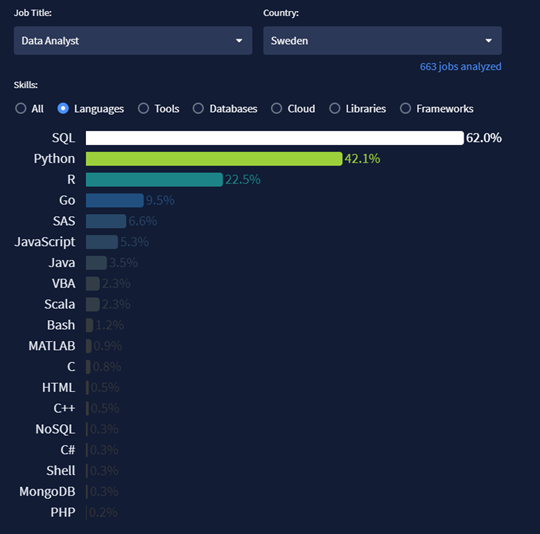
User interviews
During the first phase of the research period, I came into contact with various applications that were developed with the aim of helping data analysts to choose a path based on the skills demanded in the job advertisements[1]. The application scrapes ads from all over the world and visualizes the data in real time (Image 1.). I limited my research to a specific career in order to facilitate comparisons between the different institutions.
The next step for me was to compare the ads with the educational platform. In picture above. You can see that Python is requested in almost half of all advertisements. R is requested in less than 25% of all ads.
After retrieving information from antagning.se about all current programs, I was able to state that most of them include R as part of the education program. The program is still used, but it is not the one most in demand by employers. Then I started thinking about how to help people find different types of training where people can acquire specific skills and get certifications that employers approve. After the pandemic, many companies showed a willingness to equate different types of certifications with regular diplomas.

The data analyst program that can be read on Coursera also includes R, but it was easier for me to find this information directly. At the same time, you can read that the course does not include python, which would have made me opt out of the course immediately.The next thought was to make sure to include and link to the institutions that offer the subjects requested in the advertisements. Then you can give the users the opportunity to know very early in their process exactly what the various programs includes . Of the 22 programs related to data analysts that I found at Antagning.se, only a few write on the front page which programming languages are included.
Once I had a better understanding of how the information can be retrieved, transformed and structured, I moved on to consider how gamification could be applied to the project. I went back to the Arbetsförmedlingen's website to analyse the layout and see which parts could be presented in a different way.
User interview
To rule out assumptions, I created a Google form to find out what factors were most important to those participants when choosing a career or employer.
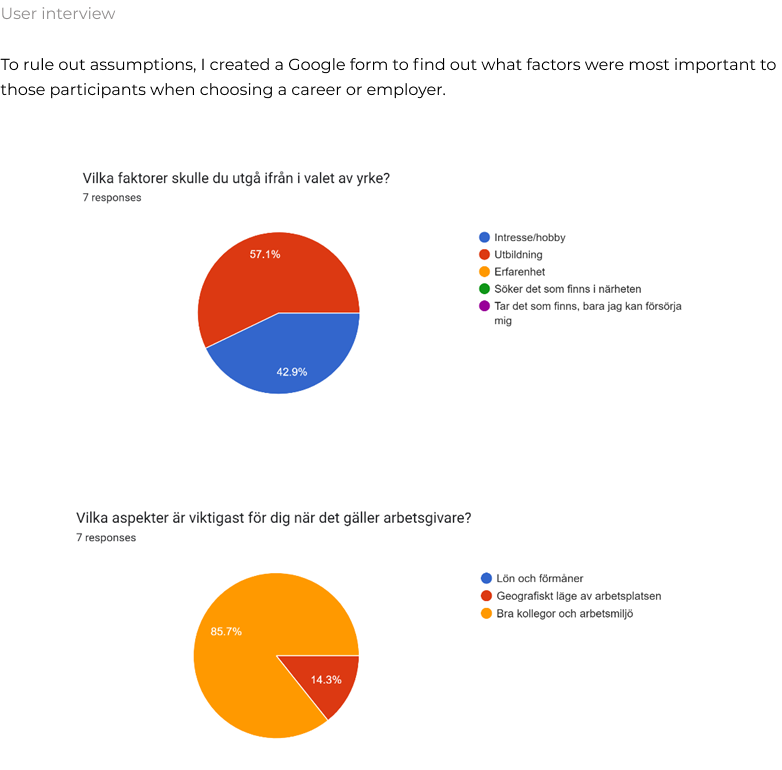
The solution
The core idea was to implement gamification i form of a dashboard where the users would be able to see all their stats at once. In order to accomplish that, some existing components were modified to fit in the new design.
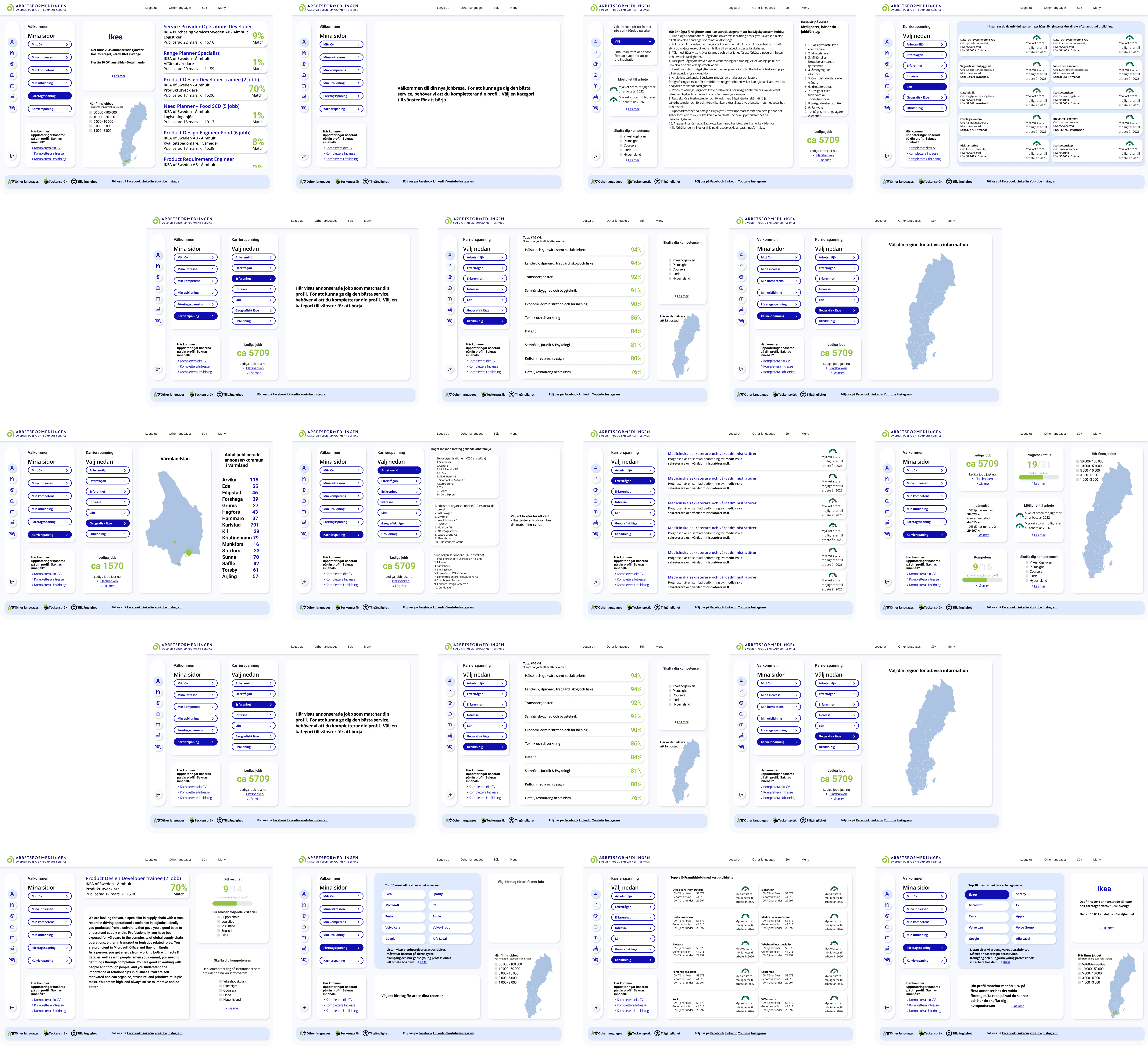
Problem statement
We had already received a persona in the briefing, and although there were some thoughts in the beginning, I chose to continue working on this and focus on how to create a position that can help it transition in the middle of working career regardless of the reason for it. After some answers started to trickle in, I started the problem formulation process.
"How can I implement gamification and what parts were appropriate for it?
"How can I present a large amount of data in a simplified way?
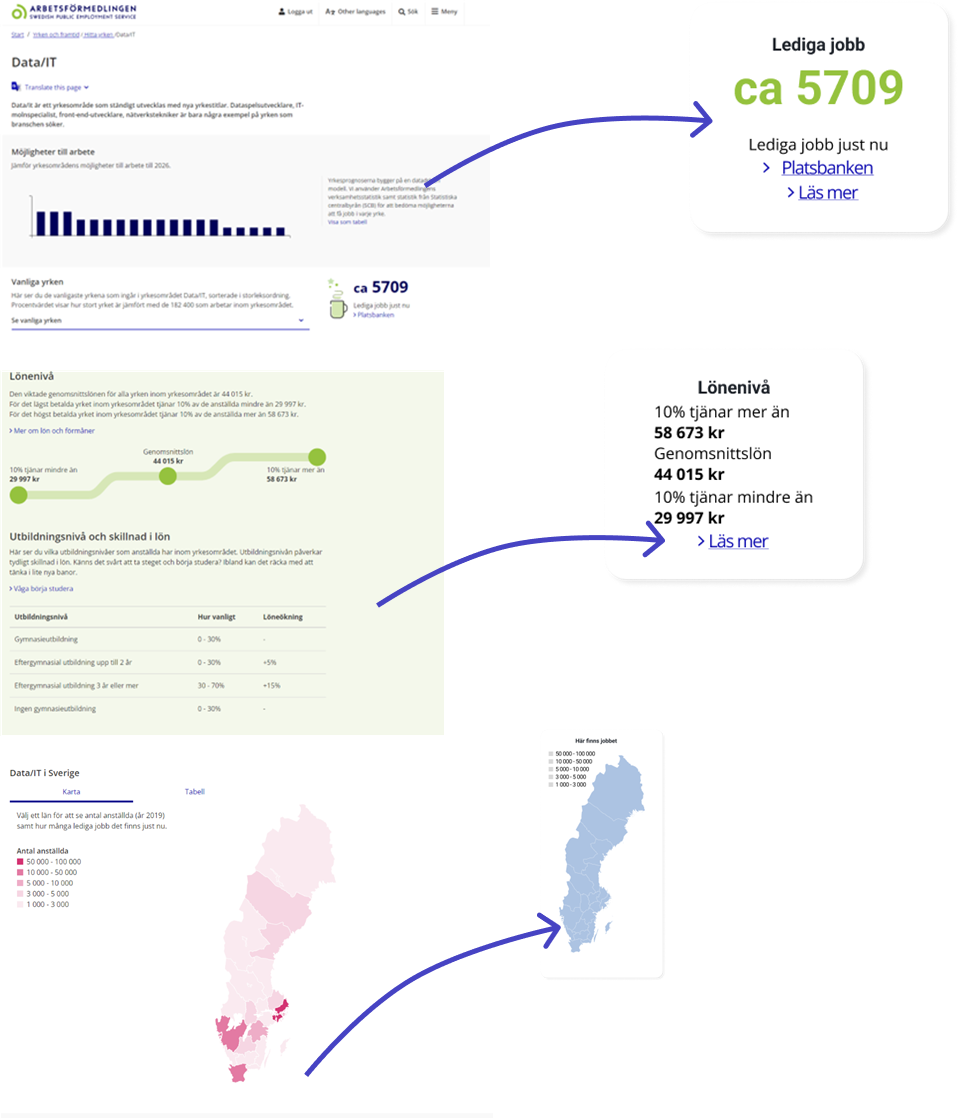
Since the beginning of the project, I continually wrote down some thoughts and now it was time to structure and group similar ideas to be able to have a starting point. The first step was to write freely which parts could be included, and then sort and implement.
Provide the opportunity to influence how much the different parameters affect the results.
Filters: experience, interest, or location
Do you want to search based on interest, experience or what the market needs.
What is most important to you: Salary, location or work environment
Where I want to work
What I have
What I need to learn
Where can I learn it?
Show progress.
Select category - show options - link to open positions- show compatibility - what I miss and where can I get that knowledge - show different paths.
Database that links interest with attributes.
Based on your hobbies/interests. You can be good at.
Question: How would you like to go on to study or choose paths?
Read, watch videos or schedule a meeting.
Categorize training plans.
Propose specific roadmaps based on real needs (database based on real needs
What kind of skills do you really need to be able to perform a specific.)
Enhancing User Pathways:
The next phase became challenging and steam original ideas were not implemented. It was important to peel everything down in order to be able to develop a finished prototype that could be tested. In the end, I decided to prioritize and develop three flows.
section Company reconnaissance Career scouting
The interest part would be based on the participants' current interest. Before conducting user tests, participants were asked questions about their hobby. I chose to put a lot of focus on how our interests help us develop different types of skills that prepare us for many professions that are not always directly related to the hobby. To speed up the process of getting suggestions for skills and careers, I used a pattern search system based on stored examples and correlations. (Chat GPT). When the answer was too related to question, I asked again the question without including the hobby to get more general answers.
Company reconnaissance: The goal here was to give users the ability to filter by company, see which services are published and get direct results on how the profile matches with the requested competencies. Here the focus would be on reminding users that they need to increase their skills to be able to work there, while at the same time getting filtered information about what skills they lack and where they can study.
Career reconnaissance: The plan here was to provide more opportunities to choose the path based on different criteria.
Prototype
Working environment would show the highest rated companies based on this criteria.
Demand, here I used info from Arbetsförmedlingen, but instead of sorting by categories, the job with best forecasts would be presented first.
Experience, would show which job matches the user has with the highest percentage. Plan to remind the user to complete their profile in order to receive accurate data.
Salary, would list out the profession that pays the highest starting salaries after completing the education. The high-paying jobs are managers in general, so here I chose to present information directly linked to education.
Geographical location, Use an interactive map to select regions and then get a list of all municipalities and the number of ads per municipality.
Education: Here you could see the educations that lead to jobs, as well as future jobs with short educations.
Testing
The first user gave me a lot of feedback that I felt was valuable and relevant. This led me to remove the left column to make more room for the text under the interest section. Some pages during career scouting were considered a bit unclear so I added more explanatory headings.
The second user thought the text was too small. Then I discovered that the prototype was shown in the wrong format, which I took with me and implemented in the remaining tests. Reactions were different and users stuck to different parts. All test subjects expressed that the position was attractive to them.
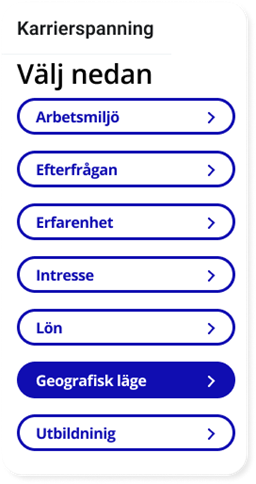
Learnings
#1
While researching for this project, I realized tha I wasn’t using Arbetsförmedlingen’s all filters in the seek job section.
#2
At the beginning of the project, I was frustrated because different institutions named the programs differently, but then I found out that it is the job of data analysts to retrieve, sort, and transform the disorganized information that exists online.
#3
That it pays off to get a functioning prototype as soon as possible to be able to get feedback from the potential users. The best improvements were implemented after the prototype testing phase.